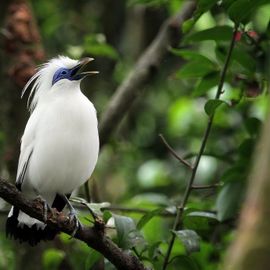Meet The Special Bali Starling In The West Bali National Park
Meet The Special Bali Starling In The West Bali National Park.
Bali is perfect. This island has many features that make you amazed. Ranging from natural attractions to educational tours. Besides tourist attractions, did you know that Bali has protected rare animals?
Bali Starling Bird
Bali Starling is also known as Bali Curik, an endemic bird species. This bird with the scientific name Leucopsar Rostchildi can only be found around Bali, especially in West Bali National Park. The melodious chirping sounds and beautiful physical appearance make this bird the target of poachers. Because of this factor, it is unfortunate that there are only 141 populations left.
Bali Starling was first discovered in 1910. The physical appearance of this bird is somewhat unique. Medium body size, ranging from 22 to 26 cm for adult birds. This bird has white dominant feathers. Only the tip of the tail and wings are black, with dark brown bird's eyes. If you look closely, in the area around the eyelids, there are bright blue fur. The bird's feet are grayish with 4 fingers. The one finger is backward while the other 3 are facing forward. Beak length reaches 2 to 5 cm with a pointed shape. A little difficult to distinguish between male and Female Bali Starling. Because their physical characteristics are almost all the same. However, male starlings are slightly larger than females and also have pigtails that look longer.
Bali Starling consumes fruits in the forest. In addition, they also eat caterpillars and small insects. For habitat, they track holes in trees to protect and also lay eggs. September to March are usually the mating period. Whereas, the spawning period usually takes place from January to March.
The number of eggs produced is not too much, usually only 2 to 4 eggs. The eggs are bluish green with an average diameter of 3 cm. Bali starlings have a very low percentage of hatching. Because only one or two eggs can be hatched. This condition is one of the causes of the difficulty in developing this population of Bali Starlings. But now, the people around the Bunaken National Park are starting to carry out conservation and extra protection so that the population does not quickly disappear.
If you are interested in seeing this rare Balinese species, you can visit the West Bali National Park in Buleleng Regency. TNBB is the original habitat of the Bali Starling. Traveling in this area won't be boring, because there are lots of exciting activities you can do, besides seeing starlings, like diving or snorkeling. Let’s take your time to see the beauty of Starling.



















